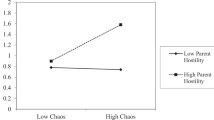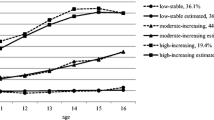Abstract
Exposure to household chaos has important implications for youth’s developmental outcomes, yet variation exists in the exposure to such environments. The dopaminergic gene system represents a biologically relevant pathway that may help account for some of the variation in the home environment. The current study tests the association between mother’s and children’s dopaminergic genotype(s) and reports of family household chaos. Genotypic data for mothers and children (N = 2605) of the Fragile Families and Child Wellbeing Study (FFCWS) are utilized to examine whether variation in mother’s and children’s dopaminergic polygenic scores comprised of four dopamine polymorphisms are associated with mother- and child-reported household chaos during ages 9–18. Children’s dopaminergic polygenic score was associated with maternal reports of household chaos at approximately age 9. Mother’s dopaminergic genotype was not significantly associated with maternal reports or child reports of household chaos. Variation in children’s dopaminergic genotype may be linked to maternal perceptions of household chaos, thereby suggesting the presence of an evocative and/or active gene-environment correlation during middle childhood.
Highlights
-
The dopaminergic system may account for variation in reports of household chaos due to the importance of dopamine for regulating attentional and inhibition processes.
-
The current study tests the association between mother’s and children’s dopaminergic genotype(s) and reports of family household chaos.
-
Children’s dopaminergic polygenic score was associated with maternal reports of household chaos at approximately age 9.

Similar content being viewed by others
References
Agrawal, A., Jacobson, K. C., Prescott, C. A., & Kendler, K. S. (2002). A twin study of sex differences in social support. Psychological Medicine, 32, 1155–1164. https://doi.org/10.1017/S0033291702006281.
Aiello, J. R., Nicosia, G., & Thompson, D. E. (1979). Physiological, social, and behavioral consequences of crowding on children and adolescents. Child Development, 50, 195–202. https://doi.org/10.2307/1129056.
Beaver, K. M., Shutt, J. E., Vaughn, M. G., DeLisi, M., & Wright, J. P. (2012). Genetic influences on measures of parental negativity and childhood maltreatment: An exploratory study testing for gene×environment correlations. Journal of Contemporary Criminal Justice, 28, 273–292. https://doi.org/10.1177/1043986212450220.
Bell, R. Q. (1968). A reinterpretation of the direction of effects in studies of socialization. Psychological Review, 75, 81–95.
Beu, N. D., Burns, N. R., & Baetu, I. (2019). Polymorphisms in dopaminergic genes predict proactive processes of response inhibition. European Journal of Neuroscience, 49, 1127–1148.
Bronfenbrenner, U. (1986). Ecology of the family as a context for human development: Research perspectives. Developmental Psychology, 22, 723–742.
Bronfenbrenner, U., & Ceci, S. J. (1994). Nature-nurture reconceptualized in developmental perspective: A bioecological model. Psychological Review, 101, 568–586. https://doi.org/10.1037/0033-295X.101.4.568.
Butcher, L. M., & Plomin, R. (2008). The nature of nurture: A genomewide association scan for family chaos. Behavior Genetics, 38, 361–371. https://doi.org/10.1007/s10519-008-9198-z.
Cardon, L. R., & Palmer, L. J. (2003). Population stratification and spurious allelic association. Lancet, 361, 598–604. https://doi.org/10.1016/S0140-6736(03)12520-2.
Cleveland, H. H., Griffin, A. M., Wolf, P. S., Wiebe, R. P., Schlomer, G. L., Feinberg, M. E., & Vandenbergh, D. J. (2018a). Transactions between substance use intervention, the oxytocin receptor (OXTR) gene, and peer substance use predicting youth alcohol use. Prevention Science, 19, 15–26.
Cleveland, H. H., Schlomer, G. L., Vandenbergh, D. J., Wolf, P., Feinberg, M. E., Greenberg, M. T., Spoth, R. L., & Redmond, C. (2018b). Associations between alcohol dehydrogenase genes and alcohol use across early and middle adolescence: Moderation × Preventive intervention. Development and Psychopathology, 30, 297–313.
Deater-Deckard, K., Mullineaux, P. Y., Beekman, C., Petrill, S. A., Schatschneider, C., & Thompson, L. A. (2009). Conduct problems, IQ, and household chaos: A longitudinal multi-informant study. Journal of Child Psychology and Psychiatry, 50, 1301–1308. https://doi.org/10.1111/j.1469-7610.2009.02108.x.
Dick, D. M., Agrawal, A., Schuckit, M. A., Bierut, L., Hinrichs, A., Fox, L., & Begleiter, H. (2006). Marital status, alcohol dependence, and GABRA2: Evidence for gene-environment correlation and interaction. Journal of Studies on Alcohol, 67, 185–194. https://doi.org/10.15288/jsa.2006.67.185.
Freedman, M. L., Reich, D., Penney, K. L., McDonald, G. J., Mignault, A. A., Patterson, N., & Altshuler, D. (2004). Assessing the impact of population stratification on genetic association studies. Nature Genetics, 36, 388–393. https://doi.org/10.1038/ng1333.
Gajos, J. M., Fagan, A. A., & Beaver, K. M. (2016). Use of genetically informed evidence‐based prevention science to understand and prevent crime and related behavioral disorders. Criminology & Public Policy, 15(3), 683–701. https://doi.org/10.1111/1745-9133.12214.
Gottfried, A., & Gottfried, A. (1984). Home environment and cognitive development in young children with middle socioeconomic status families. In A. Gottfried (Ed.), Home environment and early cognitive development (pp. 57–115). New York: Academic.
Halder, I., Shriver, M., Thomas, M., Fernandez, J. R., & Frudakis, T. (2008). A panel of ancestry informative markers for estimating individual biogeographical ancestry and admixture from four continents: Utility and applications. Human Mutation, 29, 648–658. https://doi.org/10.1002/humu.20695.
Kendler, K. S., & Baker, J. H. (2007). Genetic influences on measures of the environment: A systematic review. Psychological Medicine, 37, 615–626. https://doi.org/10.1017/S0033291706009524.
Krapohl, E., Hannigan, L. J., Pingault, J.-B., Patel, H., Kadeva, N., Curtis, C., & Plomin, R. (2017). Widespread covariation of early environmental exposures and trait-associated polygenic variation. Proceedings of the National Academy of Sciences, 114, 11727–11732. https://doi.org/10.1073/pnas.1707178114.
Lee, D., Brooks-Gunn, J., McLanahan, S. S., Notterman, D., & Garfinkel, I. (2013). The Great Recession, genetic sensitivity, and maternal harsh parenting. Proceedings of the National Academy of Sciences, 110, 13780–13784. https://doi.org/10.1073/pnas.1312398110.
Lee, S. S., Chronis-Tuscano, A., Keenan, K., Pelham, W. E., Loney, J., Van Hulle, C. A., & Lahey, B. B. (2010). Association of maternal dopamine transporter genotype with negative parenting: Evidence for gene x environment interaction with child disruptive behavior. Molecular Psychiatry, 15, 548–558.
Lucht, M., Barnow, S., Schroeder, W., Grabe, H. J., Finckh, U., John, U., & Herrmann, F. H. (2006). Negative perceived paternal parenting is associated with dopamine D2 receptor exon 8 and GABA (A) alpha 6 receptor variants: An explorative study. American Journal of Medical Genetics Part B (Neuropsychiatric Genetics), 141B, 167–172. https://doi.org/10.1002/ajmg.b.30255.
Marceau, K., Palmer, R. H. C., Neiderhiser, J. M., Smith, T. F., McGeary, J. E., & Knopik, V. S. (2016). Passive rGE or developmental gene-environment cascade? An investigation of the role of xenobiotic metabolism genes in the association between smoke exposure during pregnancy and child birth weight. Behavior Genetics, 46, 365–377. https://doi.org/10.1007/s10519-016-9778-2.
Matheny, A. P., Wachs, T. D., Ludwig, J. L., & Phillips, K. (1995). Bringing order out of chaos: Psychometric characteristics of the Confusion, Hubbub, and Order Scale. Journal of Applied Developmental Psychology, 16, 429–444. https://doi.org/10.1016/0193-3973(95)90028-4.
Mitchell, C., Hobcraft, J., McLanahan, S. S., Siegel, S. R., Berg, A., Brooks-Gunn, J., & Notterman, D. (2014). Social disadvantage, genetic sensitivity, and children’s telomere length. Proceedings of the National Academy of Sciences, 111, 5944–5949. https://doi.org/10.1073/pnas.1404293111.
Mitchell, C., McLanahan, S., Hobcraft, J., Brooks-Gunn, J., Garfinkel, I., & Notterman, D. (2015). Family structure instability, genetic sensitivity, and child well-being. American Journal of Sociology, 120, 1195–1225. https://doi.org/10.1086/680681.
Moore, S. R.(2017). Commentary: What is the case for candidate gene approaches in the era of high-throughput genomics? A response to Border and Keller. Journal of Child Psychology and Psychiatry, 58, 331–334. https://doi.org/10.1111/jcpp.12697.
Neiderhiser, J. M., Reiss, D., Pedersen, N. L., Lichtenstein, P., Spotts, E. L., Hansson, K., & Elthammer, O. (2004). Genetic and environmental influences on mothering of adolescents: A comparison of two samples. Developmental Psychology, 40, 335–351. https://doi.org/10.1037/0012-1649.40.3.335.
Petrill, S. A., Pike, A., Price, T., & Plomin, R. (2004). Chaos in the home and socioeconomic status are associated with cognitive development in early childhood: Environmental mediators identified in a genetic design. Intelligence, 32, 445–460. https://doi.org/10.1016/j.intell.2004.06.010.
Pike, A., Iervolino, A. C., Eley, T. C., Price, T. S., & Plomin, R. (2006). Environmental risk and young children’s cognitive and behavioral development. International Journal of Behavioral Development, 30, 55–66. https://doi.org/10.1177/0165025406062124.
Plomin, R., & Palfrey-Davis, O. (2006). Gene-environment interactions and correlations in the development of cognitive abilities and disabilities. In MacCabe, J., O’Daly, O., Murray, R. M., McGuffin, P., & Wright, P. (Eds.), Beyond nature and nurture in psychiatry: Genes, environment and their interplay (pp. 35–45). Andover, UK: Thomson.
Plomin, R., Reiss, D., Hetherington, E. M., & Howe, G. (1994). Nature and Nurture: Genetic contributions to measures of the family environment. Developmental Psychology, 30, 32–43. https://doi.org/10.1037/0012-1649.30.1.32.
Power, R. A., Wingenbach, T., Cohen-Woods, S., Uher, R., Ng, M. Y., Butler, A. W., & McGuffin, P. (2013). Estimating the heritability of reporting stressful life events captured by common genetic variants. Psychological Medicine, 43, 1965–1971. https://doi.org/10.1017/S0033291712002589.
Reichman, N., Teitler, J., Garfinkel, I., & McLanahan, S. (2001). Fragile families: Sample and design. Children and Youth Services Review, 23, 303–326. https://doi.org/10.1016/S0190-7409(01)00141-4.
Retz, W., Rösler, M., Supprian, T., Retz-Junginger, P., & Thome, J. (2003). Dopamine D3 receptor gene polymorphism and violent behavior: Relation to impulsiveness and ADHD-related psychopathology. Journal of Neural Transmission, 110, 561–572. https://doi.org/10.1007/s00702-002-0805-5.
Rodriguez, S., Gaunt, T. R., & Day, I. N. M. (2009). Hardy-Weinberg equilibrium testing of biological ascertainment for Mendelian randomization studies. American Journal of Epidemiology, 169, 505–514. https://doi.org/10.1093/aje/kwn359.
Rutter, M., Dunn, J., Plomin, R., Simonoff, E., Pickles, A., Maughan, B., & Eaves, L. (1997). Integrating nature and nurture: Implications of person-environment correlations and interactions for developmental psychopathology. Development and Psychopathology, 9, 335–364.
Scarr, S., & McCartney, K. (1983). How people make their own environments: A theory of genotype→ environment effects. Child Development, 54, 424–435.
Swanson, J. M., Flodman, P., Kennedy, J., Spence, M. A., Moyzis, R., Schuck, S., & Posner, M. (2000). Dopamine genes and ADHD. Neuroscience and Biobehavioral Reviews, 24, 21–25. https://doi.org/10.1016/S0149-7634(99)00062-7.
Acknowledgements
The Fragile Families and Child Wellbeing Study was supported by the Eunice Kennedy Shriver National Institute of Child Health and Human Development (NICHD) of the National Institutes of Health (R01HD036916) and a consortium of private foundations. Persons interested in obtaining the Fragile Families contract data should see http://www.fragilefamilies.princeton.edu for further information. The content is solely the responsibility of the author and does not necessarily represent the official views of the National Institutes of Health. A special acknowledgment is due to Dean Thomas G. Blomberg and the Florida State University College of Criminology and Criminal Justice for funding the application fee to obtain the Fragile Families contract data for the current project.
Author information
Authors and Affiliations
Corresponding author
Ethics declarations
Conflict of Interest
The author declares no competing interests.
Additional information
Publisher’s note Springer Nature remains neutral with regard to jurisdictional claims in published maps and institutional affiliations.
Rights and permissions
Springer Nature or its licensor holds exclusive rights to this article under a publishing agreement with the author(s) or other rightsholder(s); author self-archiving of the accepted manuscript version of this article is solely governed by the terms of such publishing agreement and applicable law.
About this article
Cite this article
Gajos, J.M. Children’s Dopaminergic Genotype is Associated with Maternal Reports of Household Chaos during Middle Childhood. J Child Fam Stud 32, 3327–3337 (2023). https://doi.org/10.1007/s10826-022-02456-1
Accepted:
Published:
Issue Date:
DOI: https://doi.org/10.1007/s10826-022-02456-1




